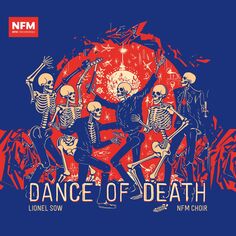Hugo Distler (1908-1942) komponierte seine Motette Totentanz für 4-stimmigen Chor a cappella im Jahre 1934 für den Totensonntag. Die fast 50 Minuten lange Komposition begreift 14 gesungene Verse aus dem Cherubinischen Wandersmann des barocken Lyrikers Angelus Silesius, zwischen denen 12 gesprochene Verse von Johannes Klöcking stehen.
Für die zweite Aufführung komponierte Distler zusätzlich kurze Variationen des Liedes ‘Es ist ein Schnitter, heißt der Tod’ für Flöte solo, die auch in dieser Aufnahme zu hören sind. Das Besondere an der Einspielung ist, dass Willard White mit seinem markanten Bass die Texte Klöckings nicht im Original rezitiert, sondern in englischer Sprache. Das ist eine Entscheidung die man nachvollziehen kann, aber nicht unbedingt billigen muss. Whites Narration ist aber ausdrucksvoll und unterscheidet sehr gut die Personen, die in Klöckings Text dem Tod gegenübertreten.
Distlers Chöre sind meist zart und schwebend und werden vom NFM Chor sehr einfühlsam gesungen. Der Gesang klingt homogen und warm, die Diktion ist freilich nicht besonders gut, und man muss schon den Text zur Hand nehmen muss, um dem Gesungenen zu folgen.
Die Flötensoli von Jan Krzeszowiec sind tadellos.
Die anderen Stücke, die die auf dem Album zu hören sind, sind in hervorragenden Interpretationen zu hören. Einmal mehr bewundert man die Homogenität, die makellose Intonation und das Engagement des Chores.
Hugo Distler (1908-1942) composed his motet Totentanz (Dance of death) for 4-part a cappella choir in 1934 for the Sunday of the Dead. The nearly 50-minute composition consists of 14 sung verses from the Cherubinischer Wandersmann by the baroque poet Angelus Silesius, interspersed with 12 spoken verses by Johannes Klöcking.
For the second performance, Distler also composed short variations on the song « Es ist ein Schnitter, heißt der Tod » for solo flute, which can also be heard on this recording. The special thing about this recording is that Willard White, with his distinctive bass, does not recite Klöcking’s texts in the original, but in English. This is a decision that is understandable, but not necessarily appreciated. However, White’s narration is expressive and distinguishes the characters facing death in Klöcking’s text very well.
Distler’s choruses are mostly tender and floating and sung very sensitively by the NFM choir. The singing sounds homogeneous and warm, although the diction is not particularly good and one has to listen to the text to follow what is being sung.
Jan Krzeszowiec’s flute solos are flawless.
The other songs on the album are presented in excellent interpretations. Once again, the homogeneity, flawless intonation and commitment of the choir are admirable.


















